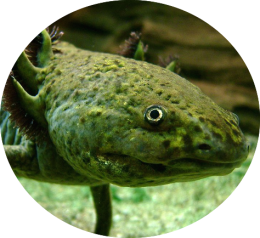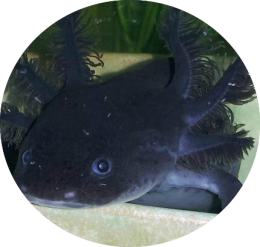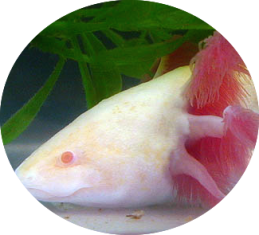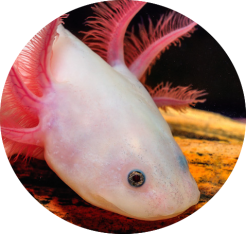For centuries, these animals have been known by many names: Mexican walking fish, water dogs, even water dragons. Today however, they are now known as the axolotl (Ambystoma mexicanum), and they are neither fish nor dog nor dragon but a salamander, an amphibian with a tail. They are expected to start life in water as eggs, metamorphose limbs, lose their gills, and eventually be able to come onto land part-time as adults. However, they defy this adult role expected of them instead retaining their gills and staying in the water. They are quite literally the salamander who never grew up.
This is but one of the many fascinating facts surrounding this salamander. Now, join me as I give you the facts behind this oddity as well as four more that characterize the axolotl.

The axolotl’s ability to retain its younger characteristics even as an adult is called neoteny (Henderson 2013). And it is not exclusive to just this species but to many you may know. You yourself are an example dear reader! You were born with a large head and small jaws as a baby and will continue to have them for the rest of your life.
Axolotls may of specially evolved this way because less predators inhabited the water as opposed to on land in its specific environment (Armstrong & Malacinski 1989). Or, maybe there were simply had better food resources in the water. Whatever the external reason it for certain affected the salamander’s anatomy, so much so that it cannot on its own initiate the process of losing its gills. Researchers have to either inject or add to its water the thyroid-stimulating hormone to force it to lose its gills and eventually move onto land.
Now, here are four other just as fascinating facts about the axolotl.
- They come in a variety of colors.
Axolotls have three kinds of pigment cells that code for specific colors (Armstrong & Malacinski 1989). Melanophores for black, xanthophores for yellow, and iridophores for shininess. The present or absence of these three results in a variety of color combinations.
A) Wild-type

What axolotls naturally look like, all other colors are artificially induced. They have all three pigment cell types.
B) Melanoid

They only have melanophores so are entirely black.
C) Albino

They have xanthophores and iridophores but lack melanophores so they are yellow and shiny.
C) Leucistic

Unlike other colors, they are not the result of a combination of pigments but the failure of pigments to migrate onto their skin. They are set apart from albinos in that they have black eyes.
Besides these colors, there are many more out there! They are quite popular as exotic pets because of it.
2. They have multiple ways of obtaining oxygen.
Axolotls have not one, not two but three ways of obtaining oxygen (Kumar & Simon 2015). Their gills as you can probably guess are one of the ways. Their skin is another way, because it is always moist it allows for easy gas exchange, not to mention the grooves on their sides provides them greater surface area. Finally, they do have small, primitive lungs to obtain oxygen whenever they choose to go to the surface. Out of the three, you would be surprised to know that they obtain most of their oxygen from their skin!
3. They have regenerating abilities.
These salamanders can recover and regrow almost any body part that was injured or missing. From limbs, tail, spinal column, jaw, gills, and even parts of the heart and brain this is an amazing feat (Kumar & Simon 2015). Researchers especially find this amazing, choosing to have axolotls as a popular research animal. Many experiments are conducted with the goal of someday allowing humans to also regenerate injured or missing body parts.

Check out this video! x
4. They are critically endangered.

Despite being common in captivity as pets and lab animals, wild axolotls are classified as critically endangered (Kumar & Simon 2015). They live in only one place: Lake Xochimilco, which is located outside of Mexico City, Mexico. While it could of been considered a lake centuries ago when the Aztecs lived there, now it is simply a series of canals. It was drained years ago with other lakes so as to keep the city safe from periodic floods, however the results were catastrophic ecologically. Given the limited living space and pollution from the city, the number of axolotls has dropped so drastically that they might never recover (Henderson 2013). Recent years has not found one sighting of the salamander, making it possibly extinct.
For readers in Illinois, the Lincoln Park Zoo is one place where you can see the wild-type axolotl. Though not the most active animals, they nevertheless are still fascinating creatures as you have read. Take the time to see them before they are eventually gone as well.
Armstrong, B, J., Malacinski, M, G. 1989. Developmental Biology of the Axolotl. Oxford University Press, NY. Print.
Henderson, C. 2013. The Book of Barely Imagined Beings: a 21st Century Bestiary. University Of Chicago Press, Chicago, IL. Print.
Kumar, A., Simon, A. 2015. Salamander in Regeneration Research: Methods and Protocols. Humana Press, Springer, NY. Print.






